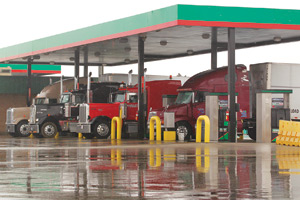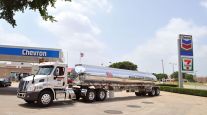Senior Reporter
Diesel Increases 6¢ to $2.370; Gasoline Rises 4.4¢ to $2.193

This story appears in the Aug. 29 print edition of Transport Topics.
The U.S. diesel average price rose 6 cents to $2.370 per gallon last week, the Department of Energy reported, as demand for the fuel rose.
It was diesel’s first increase after seven consecutive weeks of lower prices and the largest weekly jump since 6.8 cents May 2, DOE said after its Aug. 22 survey of fueling stations.
Diesel is 19.1 cents cheaper per gallon than it was a year ago.
DOE also reported the average price of regular gasoline climbed 4.4 cents per gallon to $2.193, 44.4 cents less expensive than a year ago. It marked the first rise after nine straight declines.
Crude oil futures on the New York Mercantile Exchange closed below $47 a barrel Aug. 24. That price compared with $48.52 on Aug. 19, the peak price to date for the month.
DOE reported inventories of distillate fuels, which includes ultra- low-sulfur diesel, rose by 100,000 barrels from 153 million barrels in the prior week, nearing the upper limit of the average range for this time of year. However, distillate supplies, an indication of demand, rose by 302,000 barrels to 3.8 million, compared with a week earlier.
Truckload carrier Paper Transport Inc. has a strategy of managing the cost of fuel from the truck cab by coaching drivers’ performance, PTI President Jeff Shefchik said.
“I think that plays a big part in us achieving the fuel economy we get. Not only does it help the company, but it helps them,” Shefchik said.
The company, based in Green Bay, Wisconsin, uses 7 million gallons of diesel fuel a year and operates about 620 Class 8 trucks.
“The most important factor in fuel economy is having an engaged driver, which is why PTI offers a bonus of 2.25 cents per mile to the top third of our drivers. While not all drivers receive the top bonus, 75% of them receive some monthly payout for good mpg,” said Dan Deppeler, PTI’s vice president of maintenance.
Shefchik said that can amount to $300 per month for the best drivers.
Most coaching with drivers can occur over the phone or on Skype using company-supplied tablets, but if a driver requests it, equipment managers from the carrier will ride with them to offer fuel-saving tips, Deppeler said.
The truck itself can provide information to aid in coaching, he added, including brake stops per mile, shift patterns in certain speed bands and the percentage of idling.
Using cruise control also is important in improving fuel efficiency.
“By using cruise, it allows technology in the truck to vary speed by up to 6 miles per hour. This speed variability allows trucks to slowly crest the top of hills and pick up speed going down grades,” Deppeler said. “When drivers are not in cruise control, the natural reaction is to maintain the constant governed speed, which leads to high fuel consumption.”




